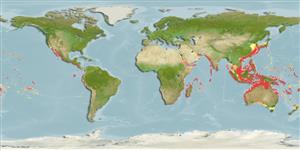Classification / Names
Common names from other countries
Main reference
Size / Weight / Age
Max length : 102 cm FL male/unsexed; (Ref. 9684); common length : 55.0 cm TL male/unsexed; (Ref. 55763); max. published weight: 10.7 kg (Ref. 168)
Environment
Marine; pelagic-neritic; oceanodromous (Ref. 51243); depth range 1 - 167 m (Ref. 58302)
Climate / Range
Subtropical; 14°C - 23°C (Ref. 168), preferred 28°C (Ref. 107945); 43°N - 41°S, 24°E - 77°W (Ref. 168)
Distribution
Indo-Pacific: widespread but with many gaps in its known distribution. Eastern Pacific: Hawaiian Islands and Pacific coast of USA to southern tip of Baja California and Tres Marias Islands extending to Cabo Blanco, Peru (especially during El Niño events), the Galapagos Islands and Gulf of Guayaquil.
Countries | FAO areas | Ecosystems | Occurrences | Introductions
Short description
Dorsal
spines
(total): 17 - 19;
Anal
spines: 0;
Anal
soft rays: 14 - 16;
Vertebrae: 44 - 45. Mouth moderately large. Laminae of olfactory rosette 21 to 39. Interpelvic process small and bifid. Body completely covered with very small scales posterior to the corselet. Swim bladder absent. Spleen large and prominent in ventral view. Liver with elongate left and right lobes and a short middle lobe. Back with narrow oblique stripes.
IUCN Red List Status (Ref. 115185)
Threat to humans
Harmless
Human uses
Fisheries: minor commercial; gamefish: yes
Tools
Special reports
Download XML
Internet sources
Estimates of some properties based on models
Phylogenetic diversity index
PD50 = 0.5312 many relatives (e.g. carps) 0.5 - 2.0 few relatives (e.g. lungfishes)
Trophic Level
4.2 ±0.69 se; Based on food items.
Resilience
Medium, minimum population doubling time 1.4 - 4.4 years (Assuming tm=3-4)
Vulnerability
Moderate to high vulnerability (51 of 100)
Price category
